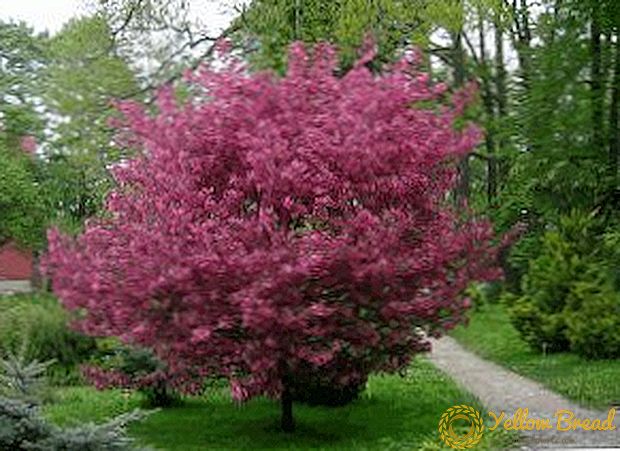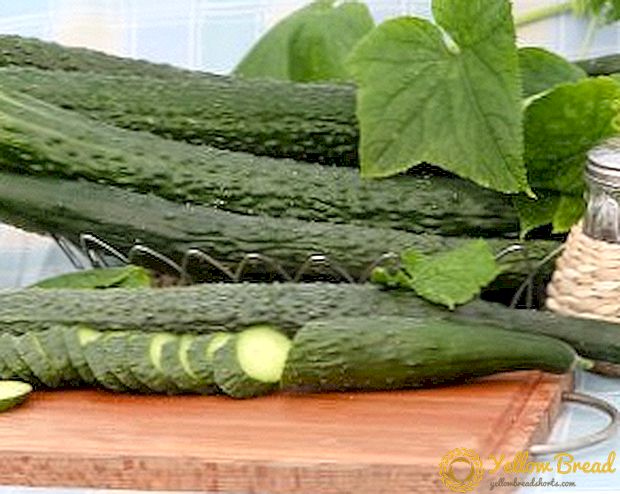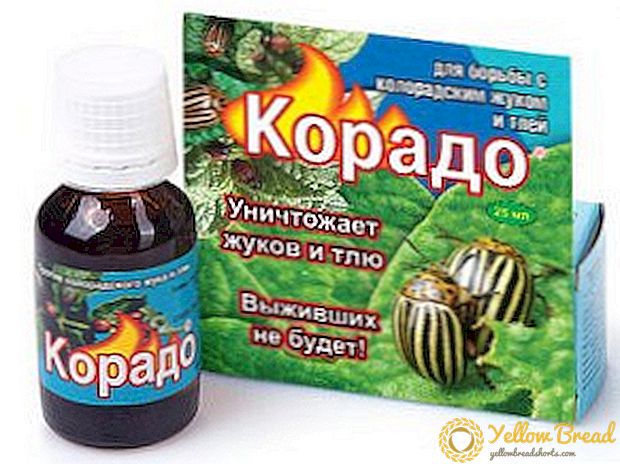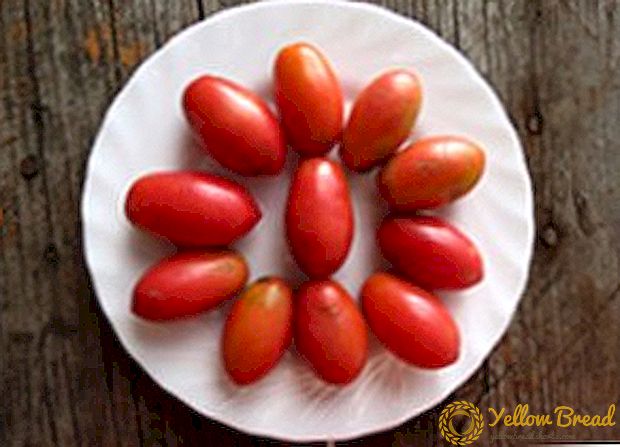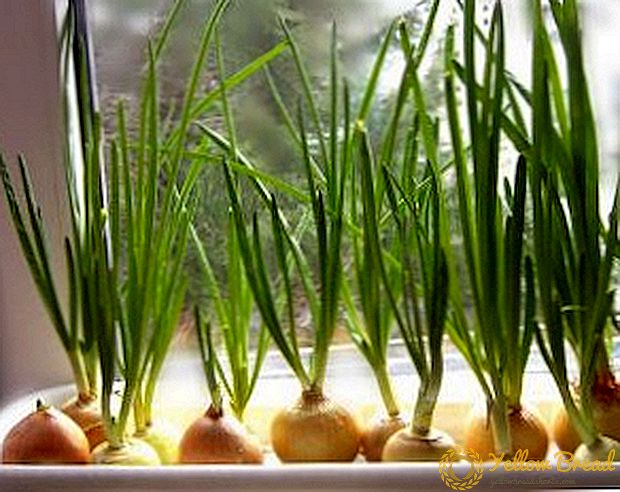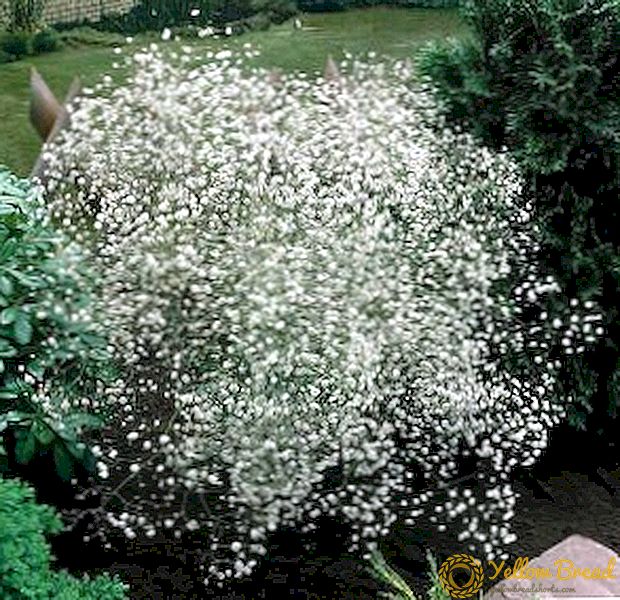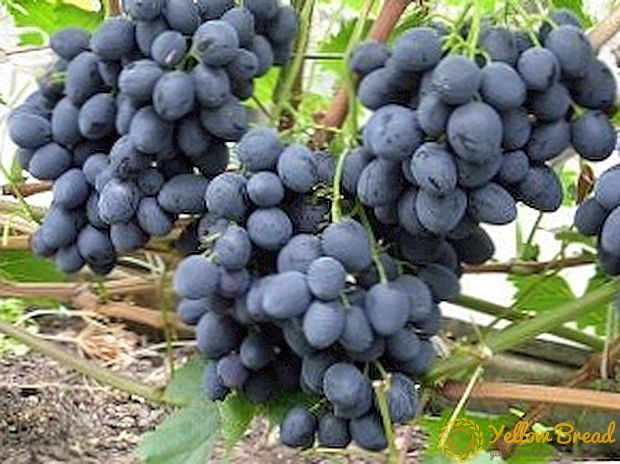
A plant like grapes is becoming more and more popular with our gardeners.
The grapes are a real storehouse of useful microelements and vitamins, which are pleasant not only to be eaten, but also to produce various other products from them.
If you want to work with a new grape variety, the Sphinx will certainly brighten up your vineyard. Now a few words about the variety itself, as well as how to care for it.
The Sphynx grape is a table grape obtained by hybridizing the Strasensky and Timur varieties by the breeder V. Zagorulno. Differs in that ripens very quickly (for 100 - 105 days). Bushes are vigorous, the leaves are large with a vein in the middle.
The shoots mature perfectly, the flowers are bisexual. Clusters of cylindrical shape, large, mass reaches 1 - 1.5 kg. Oval-shaped berries, dark blue, large, 30 x 28 mm in size, weighing up to 10 g. The flesh is very juicy, has a pleasant taste and a unique aroma. Productivity is high.
If damaged by mildew and oidium, it is not much. Shrubs "Sphinx" withstand temperatures down to -23 ° C. Despite the fact that the clusters do not have a sufficiently attractive presentation, this does not prevent the Sphynx variety from being popular among winegrowers.
Merits:
- outstanding taste
- early ripening
- high yield
- high frost resistance
disadvantages:
- slightly damaged by mildew and oidium
- average appearance of bunches
Features of planting varieties

Such a grape as the "Sphinx" can plant in spring and autumn.
If you decide to plant seedlings in the spring, then this should be done from April to mid-May, and in the fall, in October.
Under the sapling you need to dig a hole 80x80x80 cm. A layer of fertile soil lays down in a layer of 10–15 cm, which must be preserved when digging holes. To land need add 7 - 8 buckets of humus, 300 g of superphosphate and 300 g of potash fertilizers. All this needs to be mixed and well sealed. As a result, there should be a hole about 50 cm deep.
A seedling must be prepared for planting. To do this, it must be placed on the day - two in the water. After soaking, you need to remove the annual escape, but it should remain 2 - 3 peepholes. Roots need to be shortened slightly, that is, refresh.
In the center of the hole 50 cm deep, you need to form a small mound and put a seedling on it. Roots need to be evenly distributed over the formed cone.
Next, you need to fill the fertile soil into the pit so that the hole is 10 cm deep near the seedling.The ground covered should be slightly compacted. Immediately after planting in the hole you need to pour water with the calculation of 2 - 3 buckets per sapling.
Caring for the Sphinx correctly
- Watering

Grapes - quite moisture-loving plant, so it is very important to water the bushes in time with sufficient, but not excessive amount of water. Immediately after planting, you need to water each bush with 2 - 3 buckets of water. Next, you need to fill the lack of moisture no more than once every 2 - 3 weeks.
You can water the bushes through the drainage system or in special holes around the periphery of the bush. It is necessary to make such holes somewhat along the circumference (radius 0.4–0.5 m) with a depth of 15–20 cm. About 3 to 4 buckets of water should leave for one bush. After winter, the soil should be saturated with moisture, so in early spring you need water all the bushes. If the winter was wet enough, then the amount of water should be reduced. The volume of such irrigation should be 50 - 70 liters of water per 1 sq. M.
You also need to water the grapes before flowering, and 15-20 days. The first summer watering is done after the clusters have already formed. At this time, the bushes especially need water, so for 1 sq.m. should leave about 60 liters of water. Water recharge irrigation before winter should be done after the leaves have fallen. In this case, per 1 sq.m.you need to make 50 - 60 liters of water, depending on the structure of the soil and weather conditions.
- Mulching
Mulch the soil needs regularlyto keep moisture in the soil longer. Material for mulching should be placed around the trunk so that there is no touch.
First, this procedure must be carried out immediately after planting, so that the seedling is protected. Further it becomes as necessary. As you need material you can use straw, peat, humus, old leaves, grass. Now there are many new materials that can be used for these purposes. Also suitable polyethylene.
- Shelter

Preparing grapes for winter is aimed at protecting and preserving the bushes. Shelter should be made before the onset of cold weather, around the end of October. A peculiar signal for shelter is shedding of leaves. Bushes need to bind, lay On pre-bedded material, such as wooden boards, carefully secure the vines on the ground.
Further, over the entire series of grape shoots, an arch of metal arcs is installed, onto which a plastic film is stretched with one or two layers. It is very important that the material does not touch the shoots, so that there are no burns.On the side of the film you need to pour the ground or fix it in another way so that it is not blown away by the wind.
During the thaw, the ends of the film must be opened so that the shoots "breathe". You can also cover the bushes with earth. Of the same need lay on the ground, cover with earth, and then with snow.
- Pruning
Cut the bushes need to fall, when the plants are already preparing for winter. It is recommended to leave 4 "sleeves" that will bear fruit. You need to leave at least 4 - 6 eyes on the shoots. When pruning young bushes, you must first trim a matured vine, and in subsequent years, young shoots just need to be shortened.
- Fertilizer
Grapes especially need additional fertilizer in order for the bushes to bear fruit regularly and abundantly. During the growing season, fertilizing is performed at least 3 times with an interval of 3 to 4 weeks. It is not necessary to fertilize young seedlings, because a mixture of fertile soil with fertilizers was applied to the lower layer of the pit.
Grapes need nitrogen fertilizer to increase the growth of bushes. Nitrogen is introduced with organic matter. Before the flowers bloom, you need to make salts of zinc and potassium, as well as superphosphate. This will help increase the quality and quantity of the crop.
Before the onset of winter, you need to make superphosphate and potassium, so that during the cold weather the roots have additional food. Fertilizers are introduced into small depressions 30 cm deep around the bush. In addition to mineral fertilizers, grapes need and organic dressing in the form of 10 - 15 kg of compost, humus on one bush of grapes. This type of feeding is done every 2 - 3 years.
- Protection

"Sphinx" is prone to the defeat of mildew and oidium, therefore it is necessary not only as a treatment, but also as a prevention spray bushes phosphorus fungicides.
The causative agents of mildew and oidium are different types of fungus. If yellow spots or gray dust have appeared on the leaves, the grapes are infected, and urgent measures should be taken. You must spray the vines first before flowering, and then after flowering.

